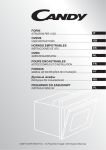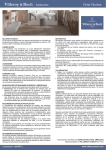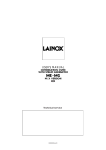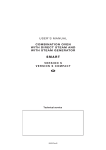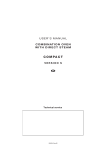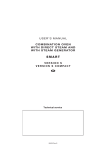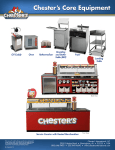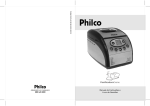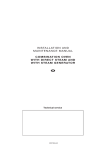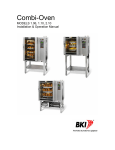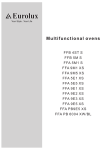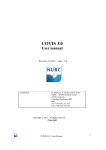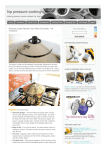Download user`s manual convection oven for pastry shops and bakeries version s
Transcript
USER’S MANUAL CONVECTION OVEN F O R PA S T RY S H O P S AND BAKERIES VERSION S EN Technical service 90025860rev00 CONTENTS Page 1 • GENERAL REMINDERS 4 2 • POINTS TO REMEMBER 5 3 • DESCRIPTION OF KEYS 6 4 • MANUAL SETTINGS FOR ONE-PHASE COOKING 8 10 5 • SETTING THE OVEN MANUALLY FOR COOKING with two or more cycles in sequence 6 • ENTERING AND SAVING A PROGRAM 12 7 • Selecting and starting a saved program 14 8 • DELETING a saved program 15 9 • Temporarily altering a saved program 15 10• Selecting and starting a PRE-STORED RECIPE 16 11• Temporarily CHANGING a STORED RECIPE 17 12• SETTING THE CORE PROBE 18 13• AUTOMATIC HUMIDITY CONTROL SYSTEM 19 14• OPERATING DETAILS 20 15• USEFUL TIPS 21 16• ROUTINE MAINTENANCE 22 17• NON-ROUTINE MAINTENANCE 22 18• SETTING THE DATE AND TIME 23 19• DOWNLOAD HACCP LOG 24 20• IMPORT/EXPORT RECIPES 25 • SPECIAL PROGRAMS - MANUAL AND AUTOMATIC CLEANING 26 21• SPECIAL PROGRAMS - MANUAL CLEANING 27 22• SPECIAL PROGRAMS - WASHING KIT 28 23• SELF-DIAGNOSIS AND FAULT IDENTIFICATION 30 24• PRE-STORED RECIPES 33 VERSIONS S - 99 program electronics, with automatic 4-cycle sequence - Cycle management key with 4 LED display - Alphanumerical displays - Pre-set recipes - Direct access key to programs and recipes - USB output - Self-diagnosis - Autoreverse (automatic inversion of fan rotation) - Lights - Two speed (except for mod. 044/054) - Power reduction - Manual or automatic controlled humidifier - Automatic vent with pre-opening control - Double-glass opening door - Standard semi-automatic washing program. OPTIONAL: Core probe - Hand-held shower - Automatic washing system, with three washing intensities The manufacturer accepts no liability for any inaccuracies in this manual attributable to printing or copying errors. We reserve the right to modify our products as we deem fit, without impairing their basic features. The reproduction or copying of any part of this manual by any means whatsoever is strictly forbidden unless authorized previously in writing by the manufacturer. - ORIGINAL INSTRUCTIONS - 3 90025860rev00 1 • general reminders Repairs may become necessary over time; these and all major servicing operations must be performed exclusively by technicians employed by the manufacturer or an authorized service centre. LOGO TYP. XXXXXXXX 2010 NR XXXXXXXXXX 3N AC 400V 50Hz 1.1 •Carefully read the directions given in this manual; they contain important information on safety during installation, operation and maintenance. Keep this manual in a safe place for future consultation! 1 x 0.25 kW TOT 6.25 1.2 •This appliance must only be used as specified in the design: i.e. cooking foods. Any other type of use is improper and therefore dangerous. TYP. XXXXXXXX kW kPa 200 - 500 IPX 5 LOGO 2010 NR XXXXXXXXXX EN 203/A1 1 x 0.55 kW A3 G 25 / AC 230V 50Hz B13 m3/h Pmax / mbar Pmin / mbar 1.3 •Only suitably trained kitchen personnel should be allowed to use the appliance. IT IPX 5 1.4 •The oven must not be left unattended during operation. TOT G 20 1 / kW B23 m3/h Pmax / mbar Pmin / mbar Cat. II 2H3+ Qn 40 kW kPa 200 - 500 G 30 3.16 Kg/h Pmin / mbar P mbar 20; 28-30/37 0085 1.9 •In the event of technical assistance being required, provide as much detailed information about the fault as possible in order to facilitate the service technician in identifying and resolving the malfunction. 1.5 •There are surfaces of the oven that become hot during operation. Take care! 1.6 •Ask the installer for information on correct operation and use of the water softener; incorrect or incomplete maintenance is at the origin of the formation of scale, which would badly damage the oven. 1.10 •In the event of breakdown or faulty operation, switch off the oven immediately! 1.11 •The room in which the oven is to operate must be well ventilated! 1.7 •Should it become necessary to call out a service technician, all essential identification details of the appliance are shown on the data plate, located at the right-hand side on the bottom. 1.12 •Safety sticker • Maximum height for inserting containers with liquids. •ATTENTION to avoid scalding, do not use the containers filled with liquid or food which, through cooking become fluid, at levels higher than those which can be observed. 1600 mm (63 inch) 1.8 •Each appliance is equipped with a data plate identifying the model and its main specifications. An example is given below of a dataplate for an electric oven and one for a gas oven. 4 90025860rev00 2 • points to remember 2.1 •Before any food is cooked in a new oven, the interior must be thoroughly cleaned (see “Daily Cleaning”). ! 2.2 •At the end of the working day, clean the oven thoroughly inside and out; this will ensure smooth operation of the appliance and prolong its useful life. 2.3 •Do not use high pressure water jets when cleaning the oven! 2.9 •CAUTION No cooking with alcohol added is permitted! 2.10 •F a i l u r e t o o b s e r v e b a s i c s a f e t y guidelines may jeopardize the smooth operation of the oven and expose the operator to serious danger! The manufacturer accepts no liability if the original function of the oven is altered or there is tampering or failure to observe the instructions given in the manuals. 2.4 •For daily cleaning, use only alkali based products suitable for the purpose. Do not use abrasive materials or products as they will damage the oven surfaces. 2.5 •Always switch off the appliance when work is finished, shutting off all utilities (electricity, water, and gas if connected). 2.11 •To ensure long term efficiency and reliability of the oven, scheduled servicing should be carried out at least once a year. With this in mind, customers are recommended to sign a service agreement. 2.6 •Avoid any operation that might cause cooking salt to be deposited on the steel surfaces of the oven; if salt is accidentally spilled, rinse off thoroughly without delay. 2.7 •After steam cooking, open the door carefully to avoid being hit by the rush of residual steam escaping from the oven. Failure to observe this warning may be dangerous for the operator. 2.8 •To ensure safe operation of the oven, do not obstruct the vents or any other opening on the oven! 5 90025860rev00 3 • description of keys 3.1 •CYCLES (KEY 1) Allows to set, recall and display the cooking cycles. The LEDs on with a fixed light indicate the cycles set. The flashing LED indicates the cycle in progress. 3.8 • Humidity control key (KEY 12) This key also performs the function of a manual humidifier when pressed with cooking in progress (key light on). This function is useful for foods that require added humidity when cooking. Press the key and hold for as long as it is wished to let moisture into the oven, the corresponding LED will light up for as long as the key is pressed. 3.2 •CONTINUOUS STEAM (KEY 2) A l l o w s c o o k i n g w i t h s t e a m b e i n g continuously introduced into the oven. 3.3 •TIMED INITIAL PUFFED STEAM (KEY 3) This allows you to set the time for a puff of steam at the start of cooking. 3.4 •REDUCED POWER (KEY 4) This allows you to reduce the oven’s power (ideal for delicate cooking). 3.5 •FAN SPEED (KEY 5) Fan speed selection key, normal with light off, reduced speed and power with light on. 3.6 •RECIPES (KEY 6) Allows to set, recall and display the cooking programs, the memorised recipes and service programs (e.g. washing the oven). 3.7 •CORE PROBE (KEY 11) Used to activate the core probe cooking setting. 6 90025860rev00 Note: The appliance is fitted with an automatic system for reducing the cavity temperature in all cooking modes. If the temperature exceeds the display setting by 30°C, the humidifier automatically directs cold water into the oven and the temperature is rapidly lowered. This precludes the possibility that food could start cooking with too high a temperature in the oven. In addition, the added moisture prevents foods from drying up. 3 • description of keys 3.9 • Oven steam extraction vent key (KEY 13) This function is only activated in convection mode. Pressing the key opens the cavity vent, allowing the escape of moisture from the cavity. (LED on = vent open; LED off = vent closed, flashing LED = vent in operation). 3.12 •MAIN SWITCH - START-STOP (KEY 15) Press button 16 for 3 seconds Allows the activation of the control panel, activates selfdiagnosis. The position of the vent (vent open/vent closed) can also be saved in several cycles of a program. 3.10 • oven light key (KEY 14) Pressing this key switches on the oven light, permitting the operator to check the progress of the cooking. 3.11 • rapid cooling key wITH oven door open (KEY 15) This function is activated only with the oven door open. Pressing the key activates the fan, which rapidly lowers the temperature in the oven to 50°C. This function is particularly useful if one cooking operation at high temperature is to be followed by another using a much lower temperature, or when the oven needs cleaning immediately after a cooking operation (see “Daily Cleaning”). 7 90025860rev00 START-STOP button: allows to start and stop the cooking in progress. •B u t t o n l i g h t o n : S TA R T, c o o k i n g started. •Flashing button light: TEMPORARY STOP obtained by opening the door. Cooking and remaining time stop. By closing the door, cooking starts again. •Button light off: DEFINITIVE STOP obtained b y p re s s i n g k e y 1 6 : c o o k i n g s t o p s definitively as if the time has expired. 4 • MANUAL SETTINGS FOR ONE-PHASE COOKING operations 4.1 • switch on Press button 16 for 3 seconds. Whenever a symbol appears in the anomalies display (display 7-9) see the “Selfdiagnosis and anomalies key” chapter. 4.2 • SELECTION Press button 2 if you wish to cook with continuous steam 4.6a •set the time The time display 9 shows [ InF ]. Turn knob 10: - to the right to set the cooking time; - to the left to set infinite time [ InF ]. Or 4.6b •set CORE PROBE See “Setting the core probe”. The settings are saved approx. 10 seconds after the last setting. Or Press button 3 if you wish to set a timed puff of steam when cooking begins [SEC] appears on display 7, turn knob 10 to set the time when steam is to be introduced when cooking begins (expressed in seconds), shown on display 9. 4.7 • SETTING THE HUMIDITY CONTROL Press button 12 to set the desired HUMIDITY CONTROL. Turn knob 10 to set the degree of humidity (from h00 - very dry to h99 - very humid), which is appears on display 9. The selected LED remains on with a fixed light. 4.8 • SET THE VENT OPENING Press key 13, display 7 shows [oFF] (vent closed), turning knob 8 displays [ on] (vent open), turning knob 8 further shows [oPE] on display 7 and [0.00] on display 9 (vent pre-opening, [0.00] minutes before the end of cooking). Knob 10 is used to change the vent preopening time, according to the time set in the cooking cycle. 4.3 •SETTING THE REDUCED SPEED Press 4 to select the reduced speed; the light is off when normal speed is selected and goes on when reduced speed is selected (ideal for delicate cooking). 4.4 •SETTING THE FAN SPEED Press 5 to select the fan speed; the light is off when normal speed is selected and goes on when reduced speed is selected. 4.5 • set the temperature The temperature display shows a value o f 1 3 0 ° C . Tu r n k n o b 8 t o s e t t h e temperature (to the right increases, to the left decreases), which will be shown in the display. 4.9 •SAVING THE COOKING If the cooking is to be memorised, hold button 1 down for 3 seconds, display 7 shows [REC], confirm memorisation by pressing knob 8. The program number where the cooking mode has been saved is shown on the display 7. Note: Approximately 10 sec. after releasing the knob, the display will revert to the actual oven temperature. 8 90025860rev00 4 • MANUAL SETTINGS FOR ONE-PHASE COOKING starting the cooking program operations Displaying and changing saved values If, during cooking, it is necessary to check the settings, press key 1, the displays will blink. If the values displayed have to be modified, use the relevant knob or keys. Press the knob to acquire the values modified or wait for about 10 secs. the new data is saved automatically, the displays are fixed on the real values. Place the food in the oven. Refer to the “Practical Advice” heading for more information. If the core probe is to be used, refer to “Setting the core probe”. 4.10 •start Press key 16 to start cooking: The LED associated with the key remains permanently alight. At this point ... the temperature display 7 indicates the actual oven temperature. The time display 9 indicates the time remaining to complete cooking. 4.11• end of cooking If infinite time has been selected, stop cooking manually by pressing key 16 for a few seconds (LED next to key 16 OFF). If a cooking time or core probe temperature has been entered, a beep will be generated when the time elapses or the set probe temperature has been reached to indicate that cooking has terminated (LED next to key 16 OFF). To stop the signal just open the door or press a knob (8 - 10). Remove the food from the oven, following the directions given under paragraph 2.7 of the “Points to remember” heading”. Note: When switching on the appliance for the first time of the day, the steam generator drains the water contained, it turns on timed steam generator washing, then, after filling with water, it AUTOMATICALLY PREHEATS the steam generator. When starting a program that includes steam or combi cooking cycles, the program is automatically started as soon as the steam generator has reached the preheating temperature so as to avoid starting the program without any steam. The intermittent LED of key 16 indicates that the steam generator has not yet reached the preheating temperature. 9 90025860rev00 5 • MANUAL SETTINGS FOR COOKING WITH UP TO 4 CYCLES IN SEQUENCE operations 5.1 • switch on Press button 16 for 3 seconds. Whenever a symbol appears in the anomalies display (display 7-9) see the “Selfdiagnosis and anomalies key” chapter. 5.5 • set the temperature OF CYCLE 1 Tu r n i n g k n o b 8 s e t s t h e c o o k i n g temperature, which is shown on the relevant display. Note: cooking in manual mode with several phases in sequence allows the pre-heating of the empty cooking chamber before cooking: just set the cycle time 1 at infinite [ InF ]. On reaching the preheat temperature, a cyclic acoustic signal and [ LoA ] on the display inform that is time to use the oven. When the door is closed, the Cycles button 1 displays the second LED (2) flashing, which indicates activation of the cooking cycle 2. Note: Approximately 10 sec. after releasing the knob, the display will revert to the actual oven temperature. 5.2 • SELECTION Press button 2 if you wish to cook with continuous steam 5.6a •set the ti m e for cycle 1 The time display shows [ InF ]. Turn knob 10: to the right to set the cooking time; to the left to set infinite time, [ InF ] thus utilizing the first cycle as preheating. Or Or 5.6b •set the core probe for CYCLE 1 Refer to “Setting the core probe”. Press button 3 if you wish to set a timed puff of steam when cooking begins [SEC] appears on display 7, turn knob 10 to set the time when steam is to be introduced when cooking begins (expressed in seconds), shown on display 9. 5.7 • SETTING THE HUMIDITY CONTROL Press button 12 to set the desired HUMIDITY CONTROL. Turn knob 10 to set the degree of humidity (from h00 - very dry to h99 - very humid), which is appears on display 9. The selected LED remains on with a fixed light. 5.3 •SETTING THE REDUCED SPEED Press 4 to select the reduced speed; the light is off when normal speed is selected and goes on when reduced speed is selected (ideal for delicate cooking). 5.4 •SETTING THE FAN SPEED Press 5 to select the fan speed; the light is off when normal speed is selected and goes on when reduced speed is selected. 10 90025860rev00 5 • MANUAL SETTINGS FOR COOKING WITH UP TO 4 CYCLES IN SEQUENCE operations 5.8 • SET THE VENT OPENING Press key 13, display 7 shows [oFF] (vent closed), turning knob 8 displays [ on] (vent open), turning knob 8 further shows [oPE] on display 7 and [0.00] on display 9 (vent pre-opening, [0.00] minutes before the end of cooking). Knob 10 is used to change the vent preopening time, according to the time set in the cooking cycle. 5.9 • select CYCLE 2 and the following ones (up to 4 CYCLES) Press the cycles button 1, the second flashing LED (2) switches-on on the cycles button. Proceed with setting as per paragraph 5.2. If other phases are desired, follow the same sequence. 5.10 • SAVING THE COOKING If the cooking is to be memorised, hold button 1 down for 3 seconds, display 7 shows [REC], confirm memorisation by pressing knob 8. The program number where the cooking mode has been saved is shown on the display 7. 5.11 • start Press key 16 to start cooking: The LED associated with the key remains permanently alight. At this point ... the temperature display 7 indicates the actual oven temperature. The time display 9 indicates the time remaining to complete cooking. The luminous dot alongside the value indicates: blinking = cooking in progress; permanently alight = cooking suspended. This occurs, for instance, when opening the door (refer to “Operating Details”). 5.12 • end of cooking An acoustic signal informs that cooking has ended (LED at the side of button 16 OFF). To stop the signal just open the door or press a knob (8 - 10). Extract the product from the cooking chamber following the indications in paragraph 2.7 in the “Particular indications” chapter. Displaying and changing saved values If, during cooking, it is necessary to check the settings, press key 1, the displays will blink. If the values displayed have to be modified, use the relevant knob or keys. Press the knob to acquire the values modified or wait for about 10 secs. the new data is saved automatically, the displays are fixed on the real values. 11 90025860rev00 6 • ENTERING AND SAVING A PROGRAM operations 6.1 • switch on the oven Press button 16 for 3 seconds. Whenever a symbol appears in the anomalies display (display 7-9) see the “Selfdiagnosis and anomalies key” chapter. 6.3 • SELECTION Press button 2 if you wish to cook with continuous steam Or Press button 3 if you wish to set a timed puff of steam when cooking begins [SEC] appears on display 7, turn knob 10 to set the time when steam is to be introduced when cooking begins (expressed in seconds), shown on display 9. 6.2 • select the program Press the Recipes button 6, the display will show [ACC], turn the knob 8 until [Pro] is displayed and confirm by pressing the knob 8. Turn the knob until the first free program is displayed (cooking mode LED flashing and also program number on the display 7 flashing) and confirm by pressing knob 8. 6.4 •SETTING THE REDUCED SPEED Press 4 to select the reduced speed; the light is off when normal speed is selected and goes on when reduced speed is selected (ideal for delicate cooking). Caution The selected LED remains on with a fixed light. The program is “new” when the LEDs of the cooking mode buttons and the program number flash on the display 7. 6.5 •SETTING THE FAN SPEED Press 5 to select the fan speed; the light is off when normal speed is selected and goes on when reduced speed is selected. The program is “busy” when one LED of the cooking mode buttons and the program number on the display 7 have a fixed light. 12 90025860rev00 6 • ENTERING AND SAVING A PROGRAM operations 6.6 • set the temperature OF CYCLE 1 Tu r n i n g k n o b 8 s e t s t h e c o o k i n g temperature, which is shown on the relevant display. Note: Approximately 10 sec. after releasing the knob, the display will revert to the actual oven temperature. 6.9 • SET THE VENT OPENING Press key 13, display 7 shows [oFF] (vent closed), turning knob 8 displays [ on] (vent open), turning knob 8 further shows [oPE] on display 7 and [0.00] on display 9 (vent pre-opening, [0.00] minutes before the end of cooking). Knob 10 is used to change the vent preopening time, according to the time set in the cooking cycle. 6.7a •set the time OF CYCLE 1 The time display shows [InF]. Turn knob 10: to the right to set the cooking time; to the left to set infinite time, [InF] thus utilizing the first cycle as preheating. Or 6.10 •select CYCLE 2 and the following ones (up to 4 CYCLES) Press the cycles button 1, the second flashing LED (2) switches-on on the cycles button. Proceed with setting as per paragraph 6.3. If other phases are desired, follow the same sequence. 6.7b • set the core probe for CYCLE 1 Refer to “Setting the core probe”. 6.8 • SETTING THE HUMIDITY CONTROL Press button 12 to set the desired HUMIDITY CONTROL. Turn knob 10 to set the degree of humidity (from h00 - very dry to h99 - very humid), which is appears on display 9. 6.11 • saving the program Hold button 1 down for 3 seconds, display 7 shows [REC], confirm memorisation by pressing knob 8. The program number where the cooking mode has been saved is shown on the display 7. 13 90025860rev00 7 • SELECTING AND STARTING A SAVED PROGRAM operations 7.1 • switch on Press button 16 for 3 seconds. Whenever a symbol appears in the anomalies display (display 7-9) see the “Selfdiagnosis and anomalies key” chapter. CAUTION: If the program requires using the core probe, connect the probe to the front panel or the display will show “Err SP” (probe error). See “self-diagnosis and fault identification”. 7.2 • retrieve Press the Recipes button 6, the display will show [ACC], turn the knob 8 until [Pro] is displayed and confirm by pressing the knob 8. Turn the knob 8 to select the program number to be recalled (see following list of recipes), shown on the display 7. 7.3 •start Viewing the settings Whenever it should become necessary during cooking to control the values set for the current phase, press button 1. If the settings of the next phases are to be displayed, press button 1 and turn the knob until the display shows the phase of interest. 7.3a • 7.3b • 7.3c • Starting a program with Starting a program with S tarting preheat preheat excluded without saved preheating If the retrieved program has preheating, display 9 will show [ InF ]. Press key 16 to start preheating. A beep and the inscription [ LoA ] on the display will signal when the oven has reached the temperature. Place the food in the oven (if the program includes cooking phases with the core probe, insert the probe in the food). Close the door. The Cycles 1 button shows the second LED (2) flashing, which indicates the activation of the cooking cycle 2. I n t ro d u c e t h e f o o d ( i f t h e program envisions phases with core probe, insert the needle into the product). Start cooking by pressing button 16 (LED on with fixed light). Press button 1 for 3 seconds or turn knob 10 until the time is taken to zero. An acoustic signal and LED 2 flashing on button 1 indicate that the pre-heating phase has been excluded. Warning: pre-heating is not only necessary when the cooking chamber is already in temperature. Place the food in the oven (if the program includes cooking phases with the core probe, insert the probe in the food). Start the first cooking cycle by pressing key 16 (LED on steady). 14 90025860rev00 a progra m 8 • DELETING A SAVED PROGRAM 8.1 • switch on Press button 16 for 3 seconds. 8.3 • DELETING Hold button 1 down for 3 seconds, display 9 shows [DEL], confirm cancellation by pressing knob 10. When cancellation has taken place, the LEDs of the button 1 flash, indicating that the program is empty. 8.2 • retrieve Press the Recipes button 6, the display 7 will show [ACC], turn the knob 8 until [Pro] is displayed and confirm by pressing the knob. Turn the knob 8 to select the program number to be recalled, shown on the display 7. 9 • TEMPORARILY ALTERING A SAVED PROGRAM Foreword The appliance permits temporarily modifying the saved program, that is for cooking in progress only. The program to be changed must have been started (key 16 with LED on steady)! When the program is stored for a product with a different size, for which it is necessary to lengthen the cooking times, it may be necessary to raise the temperature or change any of the other parameters. operations Retrieve the program and start cooking, as described previously. To modify the memorised program: Increase/decrease temperature ... Turn the knob 8 to set the new temperature value, confirm by pressing the knob or wait 10 seconds (time out). The modification is saved automatically. Increase/decrease time ... Turn the knob 10 to set the new temperature value, confirm by pressing the knob or wait 10 seconds (time out). The modification is saved automatically. Increase/decrease core probe temperature ... Turn the knob 10 to set the new temperature value, confirm by pressing the knob or wait 10 seconds (time out). The modification is saved automatically. Increase/decrease value humidity control ... Press button 12, the led flashes, set the new value by turning knob 10, confirm by pressing the knob or wait for 10 seconds (time out). The modification is saved automatically. Note: The program display 7 shows the temporary change with two steady luminous dots. The change made is cancelled when the cooking time elapses: the program will remain in the original version. 15 90025860rev00 10 • SELECTING AND STARTING A PRE-STORED RECIPE operations 10.1 •switch on Press button 16 for 3 seconds. 10.3 •start Viewing the settings Whenever it should become necessary during cooking to control the values set for the current phase, press button 1. If the settings of the next phases are to be displayed, press button 1 until the display shows the phase of interest. 10.2 •retrieve Press the Recipes button 6. The display shows [ACC], confirm by pressing the knob 8. Turn the knob 8 to select the recipe number to be recalled (see following list of recipes), shown on the display 7. IMPORTANT: if the recipe involves the use of the core probe, connect the probe to the front panel, otherwise the display will indicate the following fault “Err SP” (Core probe error) See chapter “Self-diagnosis and fault identification”. 10.3a • 10.3b • Starting a program with preheat STARTING A RECIPE WITHOUT PREHEATING If the recipe selected includes a preheating phase, the display 9 shows [ InF ]. Press button 16 to start pre-heating. A cyclical acoustic signal and [ LoA ] on the display inform when the chamber has reached the temperature. Introduce the food (if the program envisions phases with core probe, insert the needle into the product). Close the door. The Cycles button 1 shows the second LED (2) flashing, which indicates the activation of the cooking cycle 2. Place the food in the oven (if the recipe includes core probe cooking phases, insert the probe needle into the food). Start cooking by pressing button 16 (LED on with fixed light). Press button 1 for 3 seconds or turn knob 10 until the time is taken to zero. An acoustic signal and LED 2 flashing on button 1 indicate that the pre-heating phase has been excluded. Warning: pre-heating is not only necessary when the cooking chamber is already in temperature. 16 90025860rev00 11 • TEMPORARILY CHANGING A STORED RECIPE Foreword T h e a p p l i a n c e a l l o w s t h e u s e r t o make temporary modifications to a stored recipe, applying changes only t o t h e c o o k i n g c y c l e i n p ro g re s s . In order to make modifications, the recipe to be changed must first be started (button 16 with led on steady)! This option can prove essential when the stored recipe is for a different size or weight of product, meaning that cooking time or temperature must be increased or another parameter changed. operations Retrieve the stored recipe and start cooking as described previously. To modify the memorised recipe: Increase/decrease temperature ... Turn the knob 8 to set the new temperature value, confirm by pressing the knob or wait 10 seconds (time out). The modification is saved automatically. Increase/decrease time ... Turn the knob 10 to set the new temperature value, confirm by pressing the knob or wait 10 seconds (time out). The modification is saved automatically. Increase/decrease core probe temperature ... Turn the knob 10 to set the new temperature value, confirm by pressing the knob or wait 10 seconds (time out). The modification is saved automatically. Increase/decrease value automatic humidity control ... Press button 12, the led flashes, set the new value by turning knob 10, confirm by pressing the knob or wait for 10 seconds (time out). The modification is saved automatically. Note: The program display 7 shows the temporary change with two steady luminous dots. The change made is cancelled when the cooking time elapses: the program will remain in the original version. 17 90025860rev00 12 • SETTING THE CORE PROBE Foreword The core probe allows cooking to be regulated by monitoring the temperature at the core of the product. This device overrides the time setting, and cooking stops as soon as the temperature at the core of the product reaches the selected value. The core probe can be handily used as a portable thermometer, by inserting the probe in connection 17 in any time operation mode; with the oven on stand by, keeping key 11 pressed for a few seconds, display 9 will show the probe temperature for a few seconds. This permits checking the temperature at the core of the food not being cooked and therefore outside the oven. operations 12.1 •COOKING WITH CORE PROBE Caution: When cooking with the core probe and “Err SP” is shown on displays 7 and 9, it is necessary to connect the core probe to connection 17. If the first cycle is used for preheating, it is necessary to keep the probe outside the cavity; otherwise the program cannot start. Once the oven temperature has been set (as described under the relevant headings), press key 11 and turn knob 10 to set the required core temperature. Connect the core probe to connection 17, insert the probe into the food (see “Hints on using the core probe”), and proceed according to the cooking mode selected. Therefore, if you have chosen... 12.1 a • 12.1 b • 12.1 c • ONE-PHASE MULTI-PHASE A PROGRAM TO MANUAL MANUAL BE SAVED: COOKING: COOKING: press key 16 to start cooking pass on to setting the next phase or press key 16 to start the first phase of the set cooking pass on to setting the next phase or wait for automatic saving of the set program PRACTICAL EXAMPLE Setting Mode: Convection Oven temperature: 140°C Time: Infinite Core temperature: 78°C What happens Once the temperature at the core of the food reaches 78°C, with the oven temperature at 140°C, the heat source shuts off and will automatically come into operation again when the core temperature drops by 1°C. In practice, it is no longer the oven temperature setting that regulates the operation of the heat source, but the temperature selected for the core probe. Caution: Wait for a few seconds after inserting the core probe in connection 17 (the time it takes the electronic card to identify the probe), then start cooking with key 16 START/STOP. 18 90025860rev00 13 • HUMIDITY CONTROL SYSTEM Foreword The humidity control system makes it possible to keep a level of humidity in the oven when cooking by convection. This function is useful for foods that require added humidity when cooking operations 13.1 • COOKING WITH THE HUMIDITY CONTROL SYSTEM Once the cavity or core probe temperature has been set (as described under the relevant headings), press key 12 to set the desired HUMIDITY CONTROL, from h00 (very dry) to h99 (very humid). Place the food in the oven and, if the core probe is being used, insert the probe (see “Setting the core probe”), connect the core probe to connection 17 and proceed according to the cooking mode selected. Therefore, if you have chosen... Advice Defining the humidity value requires a certain amount of practical experience. Nonetheless, it is impossible to commit a catastrophic error, and this function undoubtedly enhances the appearance of the food. Ideal for: Foods that tend to dry up, or that need a humid cooking climat. 13.1 a • 13.1 b • 13.1 c • ONE-PHASE MULTI-PHASE A PROGRAM TO MANUAL MANUAL BE SAVED: COOKING: COOKING: press key 16 to start cooking Note: The vent must be closed, because if it were set open (key 13) it would cancel the setting of the humidity control. pass on to pass on to setting the next setting the phase or wait next phase or for automatic press key 16 to saving of the set start the first program after phase of the set 10 seconds cooking (TIME OUT). 19 90025860rev00 14 • operating details Foreword During cooking (LED on steady) the displays show the actual values (current status). It is anyhow possible to check the settings. For this purpose, proceed as follows: operations 14.1•DISPLAYING SETTINGS DURING COOKING PHASE (without stopping) Press key 1, the displays blink showing the previous settings. After 10 sec. the actual values reappear (TIME OUT) so in general: display blinking: value set. display on steady: actual value. 14.2•CHANGING THE SETTINGS DURING THE COOKING PHASE (without stopping) 14.2 a • TEMPERATURE AND TIME To change the setting, turn the relevant knob to set the new value (increasing to the right, decreasing to the left); the displays show the settings that have just been made, after 10 sec. the actual values reappear. 14.2 b • HUMIDITY CONTROL Press the humidity control function key 12 (the display shows [ h.. ], the previous setting). Turn knob 10 to make the new setting. After 10 sec. the actual values reappear. 14.3 •temporary stop Open the door. Cooking stops, the time remaining to the end of cooking stops until the door is closed again. Cooking starts again from the point in which it was interrupted. 14.2 c • CORE PROBE To change the setting, turn the knob 10 to set the new value. After the 10 seconds of TIME OUT the actual values reappear. 14.4 •permanent stop To stop an infinite cooking time or interrupt it definitively, press key 16. 20 90025860rev00 15 • useful tips 15.1 • preheating the oven The oven preheating cycle is extremely important and useful for successful cooking. As a general rule, always preheat the cavity when empty, setting the temperature between approximately 15% and 25% higher than that to be utilized subsequently in cooking. In the case of steam cooking, preheat the empty cavity using convection mode as this will allow temperatures of over 130°C to be selected. 15.4 • Types of container For optimum results, it is indispensable to use the right pan for the different kinds of food: aluminium or aluminium plate pans for confectionery and baked foods, perforated pans for steam cooking. 15.5 • Clearance between containers When loading the oven with the food to cook, it is recommended to pay special attention there is sufficient clearance between containers. This makes it possible for the heat and air to distribute evenly for a more uniform result, which would not be possible if the food in one pan were in contact with the pan above. 15.2 • Cooking loads The depth of the pan must be suitable for the height of the food. For even cooking, it is preferable to distribute the load over several shallow pans rather than loading just one extremely deep pan. 15.3 • Frozen/deep-frozen products The oven must be preheated and loaded respecting the quality and nature of these foods. 15.6 • Less seasoning By using this type of oven it is possible to virtually eliminate the use of seasoning, oil, butter, fat and flavouring. With a minimum use of such ingredients in cooking, the natural flavours of the food are highlighted and the nutritional content remains intact; this brings the benefits of a more dietconscious type of cuisine. ! 21 90025860rev00 •CAUTION No cooking with alcohol added is permitted! 16 • routine maintenance 16.1 • pERIODICALLY ... ... It is recommended to clean the deflector and pan racks as necessary. For this purpose, proceed as follows: •stop and shut off all utilities (electricity, water, and gas if connected); •take out the pan racks; •using a screwdriver of the right size, or a coin, unscrew the deflector screws to be able to clean the back; it is recommended to use the hand-held shower for thorough rinsing (optional); •dry with a clean cloth; •it is necessary to remove the deflector if the dirt is particularly tough to remove; do not use abrasives or scourers that would damage the steel surface; size permitting, wash the deflector in a dishwasher. Secure the deflector in the oven, making sure the two fixing screws on the righthand side are well tightened. 16.2 • PROLONGED DISUSE If the oven is to stand idle for any length of time (e.g. holidays or seasonal closing) it must be cleaned thoroughly, leaving no traces of food or dirt. Leave the door slightly ajar so that air can circulate inside the oven. Be absolutely certain to shut off all utilities (electrical power supply, water, and gas if connected). For added care after cleaning, the external surfaces can be protected by applying a proprietary metal polish. 17 • non-routine maintenance 17.1 •To ensure correct and safe operation, the oven must be inspected and serviced at least once a year by a manufacturer technician or authorized service agent. 17.2 •W i t h t h i s i n m i n d , c u s t o m e r s a re recommended to sign a service agreement. 22 90025860rev00 18 • SETTING THE DATE AND TIME operaTionS 18.1 •With the appliance live and display off, press button 6, the display 7 shows [USb], turn knob 8 until [tIM] is displayed, press the knob to confirm the selection. •Setting the hour The display 7 shows [h], and display 9 shows the time set. Turn the knob 10 to modify the hour •Setting the minutes Turn the knob 8 again, display 7 shows [Min] and display 9 shows the minutes set. Turn the knob 10 to modify the minutes •Setting the day Turn the knob 8 again, display 7 shows [dAY] and display 9 shows the day set. Turn the knob 10 to modify the day •Setting the month Turn the knob 8 again, display 7 shows [Mon] and display 9 shows the month set. Turn the knob 10 to modify the month. •Setting the year Turn the knob 8 again, display 7 shows [YEA] and display 9 shows the year set. Turn the knob 10 to modify the year Once the date and time has been set, press button 6 to memorise the values. . 23 90025860rev00 19 • DOWNLOAD HACCP LOG operaTionS 19.1 •With the appliance live and display off, press button 6, the display 7 shows [USb], turn knob 8 to confirm the selection ATTENTION: When the USB pen drive has been removed, reposition the protective plate and tighten the protection screws. The display 7 shows [hAC]. When download has been completed, the displays 7 and 9 show [USB END] Loosen the protection screws of the USB port until the protective plate is rotated by 90° in order to have access to the USB port. Insert the pen drive into the oven USB port. Press the knob 8 to confirm the selection. 24 90025860rev00 If the USB pen drive is not inserted, the displays 7 and 9 show [USB Err]. Insert the USB pen drive and press knob 8 to repeat the procedure. 20 • IMPORT/EXPORT RECIPES operaTionS 20.1 •IMPORTING RECIPES FROM USB PEN DRIVE 20.2 • EXPORTING RECIPES ONTO USB PEN DRIVE With the appliance live and display off, press button 6, the display 7 shows [USb], turn knob 8 to confirm the selection With the appliance live and display off, press button 6, the display 7 shows [USb], turn knob 8 to confirm the selection The display 7 shows [hAC],turn the knob until [IMP] is shown. The display 7 shows [hAC],turn the knob until [ESP] is shown. Loosen the protection screws of the USB port until the protective plate is rotated by 90° in order to have access to the USB port. Insert the pen drive into the oven USB port. Loosen the protection screws of the USB port until the protective plate is rotated by 90° in order to have access to the USB port. Insert the pen drive into the oven USB port. Press the knob 8 to confirm the selection. Press the knob 8 to confirm the selection. When import has been completed, the displays 7 and 9 show [USB End]. When import has been completed, the displays 7 and 9 show [USB End]. ATTENTION: When the USB pen drive has been removed, reposition the protective plate and tighten the protection screws. ATTENTION: When the USB pen drive has been removed, reposition the protective plate and tighten the protection screws. If the USB pen drive is not inserted, the displays 7 and 9 show [USB Err]. Insert the USB pen drive and press knob 8 to repeat the procedure. 25 90025860rev00 If the USB pen drive is not inserted, the displays 7 and 9 show [USB Err]. Insert the USB pen drive and press knob 8 to repeat the procedure. SPECIAL pROGRAMS MANUAL AND AUTOMATIC CLEANING • Thorough cleaning ... ... is a prerequisite for faultless cooking and better yields: • the food's own flavour remains unchanged; • during operation there are no fumes caused by burnt food residue; • energy savings; • less maintenance work and a longer service life; • the simplicity of the procedure means that a thorough clean can be carried out quickly and with minimum inconvenience to the operator: •Caution Never use direct or high-pressure jets of water to clean the outside of the oven. Never use corrosive and/or abrasive substances on steel surfaces, and avoid scouring or scrubbing with steel wool or wire brushes, as this could result in irreparable damage. Similarly, aggressive detergents, of non-alkaline formulation containing high percentages of sodium and ammonia, can soon damage the seals, jeopardizing oven efficiency and operation. The outside of the oven should be washed with a sponge and warm water with an ordinary detergent suited to the purpose. • It is recommended to use a specially formulated detergent. COMBICLEAN Alkaline detergent in a tank COMBICLEAN 10 lt. DL 010 26 90025860rev00 SPECIAL pROGRAMS 21 • MANUAL CLEANING 21.1 •EXECUTING THE MANUAL CLEANING CYCLE [CL] 6 16 7 8 9 Press the Recipes button 6, the display will show [ACC], turn the knob 8 until [SPC] is displayed and confirm by pressing the knob. Turn the knob 8 to the right until the [CL] message appears. Press button 16 to activate the MANUAL washing program, simplified successively. The display shows [rAF] if the oven temperature is high, [Att] if the oven temperature is low, on reaching the temperature, it shows [dEt In], the light of key 16 blinks to indicate a TEMPORARY STOP, a beep signals it is time to open the door and spray detergent in the oven. Close the door and press key 16 to turn the wash cycle back on, after which the operator needs to take no other action until the end of the program. If considerable deposits form on the drain filter in the middle of the bottom of the cavity, clean so as to ensure water and detergent flow out freely. The end of the program is defined by a cyclic beep, open the door to turn it off. Switch off the appliance with key 16. It is a good rule at the end of the washing cycle to rinse the inside of the oven again with the shower (optional), wipe the front seal of the oven with a sponge or cloth to protect it from early deterioration. 27 90025860rev00 SPECIAL pROGRAMS 22 • WASHING KIT The device with Cleaning Kit allows the operator to execute three cleaning cycles for the cooking compartment: “SC” SOFT CLEANING (for NORMAL dirt) - “MC” MEDIUM CLEANING (for THICK dirt) “HC” HARD CLEANING (for STUBBORN dirt) without having to intervene in the cleaning processes directly. The detergent is evenly distributed through the special nozzle at the right time, avoiding any risk of contact with the operator. Using detergents other than the one re c o m m e n d e d b y t h e m a n u f a c t u re r is advised against because it might not ensure good cleaning and could damage the integrity of the washing system. Make sure that the coupling for the detergent is properly inserted and the tank is supplied with enough of the detergent recommended by the manufacturer. Activate automatic cooling with key 15 if the oven is very hot. 22.1 •EXECUTING THE AUTOMATIC CLEANING CYCLE [SC] - [MC] - [HC]. 6 16 7 8 9 Press Recipe button 6, [ACC] appears on the display 7. Turn the knob 8 to the left until you see [SPC] and press the knob to confirm. Turn the knob 8 to the right to select the required cleaning cycle: SOFT [SC], MEDIUM [MC], o HARD [HC]. Press button 16 to start the cleaning program you have just selected. 28 90025860rev00 SPECIAL pROGRAMS 22 • WASHING KIT the display shows [rAF] if the oven temperature is high, [Att] if the oven temperature is too low The end of the SOFT clean program is defined by a cyclical audible warning. Switching off the appliance with key 16 is not permitted during operation of the SOFT CLEAN, MEDIUM CLEAN and HARD CLEAN programs; wait for the end of washing signal, to be able to switch off the appliance. The SOFT [SC], MEDIUM [MC] e HARD [HC] programs are an automatic sequence of cycles (working time and remaining time to the end of the program are visualized on display 9), to provide the best combined action of cleansing, steam cycle, rinsing alternated with the steam cycle, final rinsing combined with ventilation and drying to make the oven cavity dry and shiny. Wipe the front seal of the oven with a sponge or cloth to prevent it from deteriorating too soon. If considerable deposits form on the drain filter placed at the center of the cavity bottom, clean so as to ensure water and detergent flow out freely. Stop and shut off all utilities (electrical power supply, water, and gas if connected). Leave the door slightly ajar when the appliance is not in use. 29 90025860rev00 23 • self-diagnosis and fault identification 23.1 •Whenever the appliance is powered up by pressing the main switch, an electronic diagnostics routine is run automatically to check the principal functions. Assuming the appliance is in perfect working order, the oven temperature display shows the actual temperature in the oven, and the LEDs of the cooking mode keys all blink. At this point the cooking parameters can be entered. 23.2 •If any irregularities are discovered, on the other hand, these are indicated in the displays 7-9. Error codes are extremely important when trouble cannot be remedied by the operator, since they give the service technician an indication as to the nature of the fault. The message on the display is accompanied by a beep of 5 seconds, repeated every minute, until the oven is switched off. The main fault warning messages are: MESSAGES “ Err SC ” Message on the displays 7 and 9. Oven temperature probe faulty, switch off the oven immediately and contact a manufacturer technician or authorized service agent. “ Err Sd ” Vapour condensation temperature probe faulty. The condenser is in operation continuously, but the oven can still be used under close observation (increased water consumption), until the arrival of a service technician. “ Err SP ” Core probe faulty. Should the message appear, it is necessary to check the connector is plugged into the socket (17) properly. The oven can continue to be used until the arrival of a service technician, but without this accessory. “ no H2o ” This means there is no water: check that the shutoff valve is open and that there is water still coming from the main. If there is no supply from the main, inform the water company or agency. If there is no problem with the main, contact a manufacturer technician or authorized service agent. In the meantime, the oven can still be used in convection mode. 30 90025860rev00 23 • self-diagnosis and fault identification The main fault warning messages are: MESSAGES “ Er 1 ” The device preventing thermal overload of the motor has cut in. Switch off the oven immediately and contact a manufacturer technician or authorized service agent. “ Er 2 ” The oven safety thermostat has cut in. Switch off the oven immediately and contact a manufacturer technician or authorized service agent. “ Er 7 ” An abnormally high temperature rise has registered in the compartment housing electrical components. The oven can still be used under close observation, until the arrival of a service technician. “ Er 8 ” An excessive temperature rise registering in the electrical components compartment could result in damage to components. Switch off the oven immediately and contact a manufacturer technician or authorized service agent. “ doP ” It appears when the door is open and signals that the door microswitch fails to close the contact. Check that the door is properly closed. If the signal persists, all the technical service. “ Err dEt ” Check that the container of detergent is not empty and the detergent is withdrawn correctly. If the signal persists, call the technical after-sales service. 31 90025860rev00 23 • self-diagnosis and fault identification The main fault warning messages are: MESSAGES WARNING FOR GAS MODELS “ no GAS ” No gas. Check that the shutoff valve is open and that there is gas coming from the main. If there is no supply from the main, inform the gas company or agency. If there is no problem with the main, contact a manufacturer technician or authorized service agent. “ Err Fbc ” Gas appliances are fitted with ignition devices incorporating an automatic reset function. If automatic restore does not take place after several attempts, displays 7 and 9 will show the error code [ Err Fbc ], given in the margin. An acoustic signal warns the operator. Press key 16 to restore ignition. If the fault persists, contact a manufacturer technician or authorized service agent. Note: Burner shutdown is a safety condition. Therefore, this situation is not a sign of the appliance malfunctioning. If, after carefully carrying out these checks, the appliance still does not function properly, call a manufacturer technician or authorized service agent. Note: When contacting manufacturer service technicians, try to explain the fault in as much detail as possible, referring all the information indicated on the identification data plate. “ Err brx ” Burners Alarm. Switch the oven off immediately and call the technical after-sales service. Note: x indicates the number of the burner in alarm conditions. 32 90025860rev00 24 • PRE-STORED RECIPES - TIMED REcIPES L1 L2 L3 L4 L5 L6 L7 L8 L9 L10 L11 L12 L13 L14 L15 L16 L17 L18 L19 L20 L21 L22 L23 L24 L25 L26 L27 L28 L29 L30 L31 L32 L33 Fresh strudel 500 gr. Frozen strudel 1 Kg. Dry fruit cake Granny cake Plum cake Fruit cakes Fresh meringues Puffs Small puffs S. Giacomo puffs Cat’s tongues Shortcrust pastry biscuits Petit four biscuits Cantucci biscuits Shortcrust/short pastry tarts 5 mm puff pastry Short pastry savoury cakes Flat biscuit Bisquit Roulè Savour/sweet ranchen Tin sponge cake Pan sponge cake 300 gr. frozen baguette Chocolate croissants Small fresh bread Slice/sandwich bread Walnut bread 500 gr. Ciabatta bread Butter rolls 50 gr. Italian breadsticks Apulian bread 1 Kg. Bread from Tuscany 1 Kg. Ferrarese bread 200 gr. L34 L35 L36 L37 L38 L39 L40 L41 L42 L43 L44 L45 L46 L47 L48 L49 L50 L51 Pre-cooked frozen pizza Fresh round pizza Sliced pizza Genoese focaccia Apulian and Ligurian Focaccia Fresh croissants 50% pre-cooked croissants Frozen croissants Sweet or savoury croissants 30-50 gr. Babà Panettone or colomba 1 Kg. Sweet focacce 1 Kg. Creme caramel Frozen vol au vent Chocolate/Vanilla soufflè Sweet or savoury flan Slow thawing Quick thawing - REcIPES WITH CORE PROBE L52 L53 L54 L55 L56 L57 L58 L59 L60 L61 L62 L63 L64 Fruit cakes w/probe Angel food cake w/probe Granny cake w/probe Plum cake w/probe Tin sponge cake w/probe Pan sponge cake w/probe Apulian bread w/probe Bread from Tuscany w/probe Ferrarese bread w/probe Panettone or colomba w/probe Sweet focacce w/probe Slow thawing with probe Quick thawing with probe N.B.: Recipes with core probe are only displayed if the oven is actually equipped with a core probe. 33 90025860rev00 24 • PRE-STORED RECIPES % of humidity / Vent position Cooking cycle Mode FFAST DRY R Convection cooking mode FAST DRY n’ Steam cooking mode FAST DRY Vent closed Vent open N° of minutes of vent pre-opening Ventilation speed (* where present) Oven temperature Standard speed Cooking time Reduced speed Core temperature TIMED RECIPES L01 Fresh strudel 500 gr. L04 Mode Granny cake Mode 1 170°C 10’ -- 20% 1 160°C 30’ -- -- 2 180°C 15’ -- FAST DRY 2 165°C 20’ -- FAST DRY L02 Frozen strudel 1 Kg. L05 Mode Plum cake Mode 1 170°C 15’ -- 20% 1 165°C 20’ -- -- 2 175°C 10’ -- -- 2 165°C 20’ -- FAST DRY 3 175°C 10’ -- FAST DRY 1 170°C 20’ -- -- 2 160°C 20’ -- FAST DRY L06 L03 Dry fruit cake Fruit cakes Mode Mode 1 170°C 20’ -- 20% 2 160°C 10’ -- FAST DRY Note: Always pre-heat the oven! 34 90025860rev00 24 • PRE-STORED RECIPES TIMED RECIPES L07 Fresh meringues L12 Mode L08 Mode 100°C 1 180’ -- FAST DRY 1 160°C 10’ -- -- 2 170°C 5’ -- FAST DRY Puffs L13 Mode 1 200°C 5’ -- 30% 2 180°C 10’ -- -- 3 170°C 9’ -- L09 Shortcrust pastry biscuits 4’ Petit four biscuits Mode FAST DRY Small puffs 1 170°C 15’ -- -- 2 160°C 10’ -- -- L14 Mode Cantucci biscuits Mode 1 200°C 3’ -- 30% 1 170°C 20’ -- 10% 2 180°C 10’ -- -- 2 140°C 20’ -- FAST DRY 3 170°C 5’ -- FAST DRY L15 Shortcrust/short pastry tarts L10 S. Giacomo puffs Mode Mode 1 190°C 5’ -- 30% 2 180°C 10’ -- -- 3 170°C 7’ -- FAST DRY 1 160°C 15’ -- 50% 2 170°C 17’ -- FAST DRY L16 5 mm puff pastry Mode L11 Cat’s tongues Mode 1 180°C 10’ Note: Always pre-heat the oven! -- 1 170°C 10’ -- 20% 2 180°C 15’ -- FAST DRY FAST DRY 35 90025860rev00 24 • PRE-STORED RECIPES TIMED RECIPES L17 Short pastry savoury cakes L23 Mode 300 gr. frozen baguette Mode 1 160°C 20’ -- FAST DRY 1 165°C 12’ -- 20% 2 170°C 20’ -- FAST DRY 2 180°C 7’ -- FAST DRY L18 L24 Flat biscuit Mode Mode 190°C 1 L19 8’ -- FAST DRY 1 160°C 3’ -- 30% 2 167°C 14’ -- FAST DRY Bisquit Roulè L25 Mode 200°C 1 L20 Chocolate croissants 8’ -- Mode FAST DRY Savour/sweet ranchen Mode 1 165°C 18’ -- -- 2 175°C 5’ -- -- Small fresh bread 30 gr. 1 150°C 4’ -- 60% 2 170°C 10’ -- -- 3 180°C 7’ -- FAST DRY L26 Slice/sandwich bread Mode L21 Tin sponge cake Mode 1 150°C 15’ -- 40% 2 160°C 7’ -- FAST DRY 1 180°C 5’ -- 50% 2 180°C 20’ -- -- 3 190°C 10’ -- FAST DRY L27 L22 Walnut bread Mode Pan sponge cake Mode 1 150°C 15’ -- -- 2 160°C 10’ -- -- Note: Always pre-heat the oven! 1 190°C 5’ -- 50% 2 190°C 12’ -- -- 3 180°C 14’ -- FAST DRY 36 90025860rev00 24 • PRE-STORED RECIPES TIMED RECIPES L28 L33 500 gr. Ciabatta bread Mode Ferrarese bread 200 gr. Mode 1 190°C 10’ -- 60% 1 200°C 10’ -- 60% 2 180°C 10’ -- -- 2 190°C 15’ -- -- 3 185°C 10’ -- FAST DRY 3 180°C 10’ -- FAST DRY 8’ -- FAST DRY 3’ -- FAST DRY L29 L34 Butter rolls 50 gr. Mode Mode 1 160°C 8’ -- 60% 2 175°C 10’ -- FAST DRY 200°C 1 L35 L30 Pre-cooked frozen pizza Italian breadsticks Fresh round pizza Mode Mode 285°C 1 1 180°C 5’ -- -- 2 185°C 5’ -- FAST DRY L36 Sliced pizza Mode L31 Apulian bread 1 Kg. Mode 1 150°C 10’ -- 60% 2 155°C 30’ -- -- 3 165°C 10’ -- FAST DRY L32 1 170°C 12’ -- 30% 2 180°C 10’ -- FAST DRY L37 Genoese focaccia Mode Bread from Tuscany 1 Kg. 1 170°C 10’ -- -- 2 180°C 12’ -- FAST DRY Mode 1 180°C 10’ -- 60% 2 180°C 30’ -- -- 3 170 10’ -- FAST DRY °C Note: Always pre-heat the oven! L38 Apulian and Ligurian Focaccia Mode 1 175°C 5’ -- 40% 2 160°C 20’ -- FAST DRY 37 90025860rev00 24 • PRE-STORED RECIPES TIMED RECIPES L39 Fresh croissants L44 Mode Panettone or colomba 1 Kg. Mode 1 165°C 12’ -- 20% 1 150°C 20’ -- 2 180°C 7’ -- FAST DRY 2 160°C 35’ -- L40 50% pre-cooked croissants L45 Mode 20’ FAST DRY Sweet focacce 1 Kg. Mode 1 160°C 2’ -- 30% 1 140°C 20’ -- 2 170°C 6’ -- FAST DRY 2 150°C 30’ -- 45’ -- 20’ -- L41 40% Frozen croissants L46 Mode 40% 15’ FAST DRY Creme caramel Mode 1 160°C 5’ -- 40% 2 165°C 10’ -- -- 3 170°C 5’ -- FAST DRY 85°C 1 L47 FFAST DRY R Frozen vol au vent Mode L42 Sweet or savoury croissants 180°C 1 10’ FAST DRY Mode 1 160°C 5’ -- 40% 2 165°C 10’ -- -- 3 170°C 5’ -- FAST DRY L43 L48 Chocolate/Vanilla soufflè Mode 1 165°C 5’ -- -- 2 170°C 10’ -- -- 30-50 gr. Babà Mode L49 1 170°C 2’ -- 30% 2 170°C 10’ -- 15% 3 175°C 8’ -- FAST DRY Note: Always pre-heat the oven! Sweet or savoury flan Mode 1 38 90025860rev00 175°C 20’ -- 5’ FAST DRY 24 • PRE-STORED RECIPES TIMED RECIPES - THAWING L50 Slow thawing L51 Mode Mode 30°C 1 Quick thawing INF -- -- 30°C 1 INF -- -- 40% RECIPES WITH CORE PROBE L52 Fruit cakes w/probe L56 Mode Tin sponge cake w/probe Mode 1 150°C -- 65°C 40% 1 165°C -- 65°C 2 160°C -- 98°C FAST DRY 2 170°C -- 98°C L57 Pan sponge cake w/probe L53 Angel food cake w/probe Mode Mode 1 175°C 20’ -- 2 170°C -- 85°C L54 -FAST DRY Granny cake w/probe 1 150°C -- 65°C 2 160°C -- 98°C L58 Mode 40% FAST DRY Apulian bread w/probe Mode 1 160°C 30’ -- -- 1 150°C -- 65°C 2 165°C -- 85°C FAST DRY 2 160°C -- 98°C L55 FAST DRY Plum cake w/probe L59 Mode 40% FAST DRY Bread from Tuscany w/probe Mode 1 165°C 25’ -- -- 1 200°C 5’ -- -- 2 175°C -- 96°C FAST DRY 2 180°C -- 90°C -- 3 170°C -- 95°C FAST DRY Note: Always pre-heat the oven! 39 90025860rev00 24 • PRE-STORED RECIPES RECIPES WITH CORE PROBE L60 Ferrarese bread w/probe L62 Mode Sweet focacce w/probe Mode 1 200°C 5’ -- 60% 1 140°C -- 50°C -- 2 190°C 15’ -- -- 2 150°C -- 96°C 20% 3 180°C -- 95°C FAST DRY 3°C -- L61 Panettone or colomba w/probe Mode 1 150°C -- 65°C 40% 2 160°C -- 98°C FAST DRY RECIPES WITH CORE PROBE - THAWING L63 Slow thawing with probe L64 Mode 1 Quick thawing with probe Mode 30°C -- Note: Always pre-heat the oven! 3°C -- 1 40 90025860rev00 30°C -- notes 41 90025860rev00 notes 42 90025860rev00 DESCRIPTION OF DISPLAY AND KEYS VERSION S 1 1 2 3 4 2 3 5 4 6 7 8 9 11 10 14 FAST DRY 13 12 15 16 17 18 1 - Cooking cycle button 10 - Knob for setting/selecting Time/Core Temperature 2 - Continuous steam key 11 - Button for cooking with core temperature probe 3 - Timed initial puffed steam key 12 - Button for humidity control, Manual humidifier button 4 - Normal/reduced power selection key 13 - Button for cavity vent 5 - Normal/reduced ventilation speed selection key 14 - Oven lights key 6 - Cooking/recipes programs button 15 - Button for fast cooling with door open 7 - Display showing cooking chamber temperature and the 16 - Main switch - Start/Stop button program/recipe 8 - Temperature setting/selection knob 9 - Display with cooking time (remaining/set), product core temperature display (real/set), humidity display 17 - Core temperature probe connection 18 - Core temperature probe















































